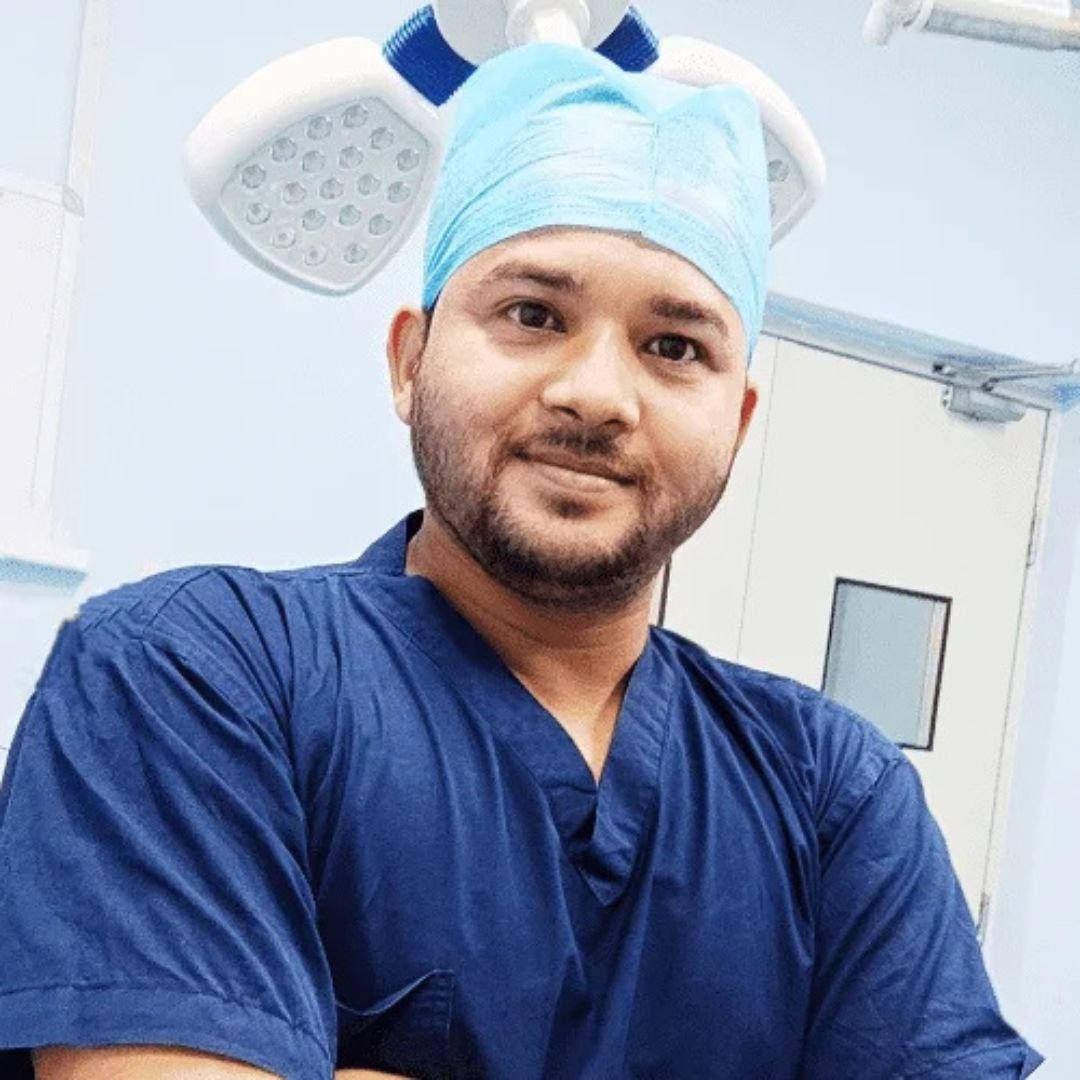Septoplasty Surgery - A Comprehensive Guide to Nasal Septum Correction
One of the most common nasal surgeries performed worldwide is septoplasty, a procedure designed to correct a deviated nasal septum. The nasal septum is the thin wall of cartilage and bone that separates the two nostrils. When this septum is crooked or deviated, it can lead to breathing difficulties, chronic sinus issues, and even sleep apnea. At Bharatkare, we specialize in advanced septoplasty surgery techniques, including FESS septoplasty, to ensure optimal results for our patients. If you’re considering septoplasty, this guide will provide you with everything you need to know about the procedure, recovery, and more.
Book Appointments With Our Expert Doctors Near You
- Get consultation for 50+ diseases across India
- In-person and online consultation with experienced doctors
- Extensive medical assistance throughout your treatment


Dr Ashish Sachdeva
MBBS, MS - General Surgery, General Surgeon, Bariatric Surgeon, Laparoscopic Surgeon
4.9/5
20 Years Experience
Vadodara, India

Dr. Tanmay Jain
General Surgeon, Laparoscopic Surgeon and Proctologist
4.9/5
12 Years Experience
Jaipur, India

Dr. Vikram Vasuniya
MBBS, MS (General Surgery) General Laparoscopic & Laser Surgeon, Laser Proctologist
4.9/5
14 Years Experience
Bhopal, India

Dr. Sujeet Kumar Bharti
MBBS, MS (General Surgery) General Laparoscopic & Laser Surgeon, Laser Proctologist
4.9/5
22 Years Experience
Patna, India
What is Septoplasty?
Septoplasty is a surgical procedure aimed at straightening the nasal septum, the partition between the two nasal passages. A deviated septum can be congenital (present from birth) or result from an injury or trauma to the nose. This condition can cause a range of symptoms, including:
- Difficulty breathing through one or both nostrils
- Frequent sinus infections
- Nasal congestion or blockage
- Nosebleeds
- Snoring or sleep apnea
- Facial pain or headaches
The goal of septoplasty surgery is to improve nasal airflow and alleviate these symptoms by repositioning or reshaping the septum. Unlike rhinoplasty, which focuses on the external appearance of the nose, septoplasty is primarily a functional procedure. However, in some cases, septoplasty may be combined with rhinoplasty (referred to as septoplasty and rhinoplasty) to address both functional and cosmetic concerns.
Piles are generally not a serious medical condition and can often be treated with lifestyle changes and home remedies for piles, such as increasing fiber intake, drinking plenty of water, practicing good hygiene, using over-the-counter creams or ointments, and avoiding straining during bowel movements. However, in more severe cases, surgical procedures like laser treatment for piles or piles operation may be required.
Disease name
Deviated Nasal Septum
Surgery name
Septoplasty
Duration
1 - 2 hours
Treated by
ENT Surgeons (Otolaryngologists)
Types of Septoplasty: FESS Septoplasty and Traditional Septoplasty
There are two main types of septoplasty procedures: traditional septoplasty and FESS septoplasty (Functional Endoscopic Sinus Surgery).
- Traditional Septoplasty: This is the standard approach where the surgeon makes an incision inside the nostril to access the septum. The deviated portions of the septum are then straightened or removed. This method is effective for mild to moderate deviations.
- FESS Septoplasty: This advanced technique uses an endoscope, a thin tube with a camera and light, to visualize the nasal passages and septum. FESS septoplasty is particularly beneficial for complex cases where the deviation is severe or involves the deeper structures of the nose. It is a minimally invasive procedure that offers precise correction with minimal tissue disruption.
Septoplasty Before and After: What to Expect
Understanding the septoplasty before and after process is crucial for patients considering this surgery. Here’s a breakdown of what you can expect:
Before Surgery:
- Consultation: Your surgeon will evaluate your nasal structure using imaging techniques like CT scans or nasal endoscopy.
- Preparation: You may be advised to stop taking certain medications (like blood thinners) and avoid smoking to reduce the risk of complications.
- Anesthesia: Septoplasty is typically performed under local or general anesthesia, depending on the complexity of the procedure.
After Surgery:
- Immediate Recovery: You may experience mild discomfort, swelling, and nasal congestion for a few days. Nasal packing or splints may be placed to support the septum during healing.
- Long-Term Results: Most patients notice a significant improvement in breathing and a reduction in sinus-related symptoms within a few weeks. Full recovery can take up to 3-6 months.
Septoplasty Recovery: Day by Day Guide
The septoplasty recovery process varies from person to person, but here’s a general timeline:
- Day 1-3: Expect nasal congestion, mild pain, and fatigue. Nasal packing (if used) is usually removed within 24-48 hours.
- Day 4-7: Swelling and bruising around the nose and eyes begin to subside. You may resume light activities but avoid strenuous exercise.
- Week 2-4: Most patients can return to work or school. Nasal breathing improves as the internal swelling decreases.
- Month 1-3: The nasal septum continues to heal, and any residual swelling resolves. Follow-up appointments with your surgeon are essential to monitor progress.
Septoplasty Recovery Time: Factors Influencing Healing
The septoplasty recovery time depends on several factors, including:
- The extent of the deviation
- The surgical technique used (traditional vs. FESS septoplasty)
- The patient’s overall health and adherence to post-operative care instructions
On average, patients can expect to resume normal activities within 1-2 weeks, but complete healing may take several months.
Septoplasty Procedure Steps: A Detailed Look
The septoplasty procedure steps are as follows:
- Anesthesia: The patient is administered local or general anesthesia to ensure comfort during the procedure.
- Incision: The surgeon makes a small incision inside the nostril to access the septum.
- Reshaping: The deviated portions of the septum are straightened or removed. In some cases, cartilage may be repositioned or grafted.
- Closure: The incision is closed with dissolvable stitches, and nasal packing or splints may be placed to support the septum.
- Recovery: The patient is monitored in a recovery room before being discharged the same day.
Septoplasty Complications: What You Need to Know
While septoplasty is generally safe, like any surgery, it carries some risks. Potential septoplasty complications include:
- Bleeding or infection
- Scarring or adhesions inside the nose
- Persistent nasal congestion
- Changes in nasal shape (rare)
- Septal perforation (a hole in the septum)
Choosing an experienced surgeon and following post-operative care instructions can minimize these risks.
Septoplasty vs Rhinoplasty: Key Differences
Many patients confuse septoplasty with rhinoplasty, but these procedures serve different purposes:
- Septoplasty: Focuses on correcting a deviated septum to improve breathing and nasal function.
- Rhinoplasty: A cosmetic procedure aimed at reshaping the nose for aesthetic purposes.
In some cases, a combined septoplasty and rhinoplasty procedure may be performed to address both functional and cosmetic concerns.
Septoplasty Incision: Minimally Invasive Approach
The septoplasty incision is made inside the nostril, ensuring no visible scars. This minimally invasive approach contributes to faster healing and reduced post-operative discomfort.
Septoplasty Recovery Day by Day: What to Expect
Here’s a detailed septoplasty recovery day by day guide:
- Day 1-2: Rest is essential. You may experience nasal congestion and mild pain.
- Day 3-5: Nasal packing (if used) is removed. Swelling and bruising begin to subside.
- Week 1-2: Most patients resume light activities. Nasal irrigation may be recommended to keep the nasal passages clean.
- Month 1-3: Full recovery is achieved, and final results become apparent.
Septoplasty Surgery Time: How Long Does It Take?
The septoplasty surgery time typically ranges from 30 to 90 minutes, depending on the complexity of the procedure. Most patients can go home the same day.
Septoplasty Cost in India: Affordable and Effective
The septoplasty cost in India is significantly lower compared to Western countries, making it a popular destination for medical tourism. At Bharatkare, we offer competitive pricing without compromising on quality. For detailed pricing, feel free to contact us.
Difference Between SMR and Septoplasty
One of the most common questions patients have is about the difference between SMR and septoplasty. Both procedures aim to improve nasal breathing, but they differ in scope and technique.
- Submucosal Resection (SMR):
- SMR is an older technique where a portion of the deviated septum is removed to improve airflow.
- It is less precise than modern septoplasty and may result in a weakened nasal structure.
- SMR is rarely performed today due to the availability of more advanced techniques.
- Septoplasty:
- Septoplasty is a more refined procedure that focuses on reshaping and repositioning the septum rather than removing large portions of it.
- It preserves the structural integrity of the nose and offers better long-term results.
- FESS septoplasty, a modern variation, uses endoscopic technology for even greater precision.
For patients seeking a long-lasting solution to nasal obstruction, septoplasty is the preferred choice over SMR.
Septoplasty FESS Surgery: The Gold Standard
FESS septoplasty (Functional Endoscopic Sinus Surgery) has revolutionized the field of nasal surgery. Here’s why it’s considered the gold standard:
- Minimally Invasive: The use of an endoscope allows surgeons to perform the procedure through small incisions, reducing tissue damage and speeding up recovery.
- Precision: The high-definition camera provides a clear view of the nasal structures, enabling precise correction of even complex deviations.
- Comprehensive Approach: FESS septoplasty can address not only the septum but also other sinus-related issues, such as polyps or chronic sinusitis.
- Faster Recovery: Patients undergoing FESS septoplasty typically experience less post-operative pain and a quicker return to normal activities compared to traditional methods.
At Bharatkare, our surgeons are highly skilled in FESS septoplasty, ensuring optimal results for our patients.
Septoplasty Recovery Time: What Influences It?
The septoplasty recovery time can vary depending on several factors:
- Surgical Technique: FESS septoplasty generally has a shorter recovery time compared to traditional septoplasty due to its minimally invasive nature.
- Patient Health: Individuals with good overall health tend to heal faster.
- Post-Operative Care: Adhering to your surgeon’s instructions, such as avoiding strenuous activities and keeping the nasal passages clean, can significantly impact recovery.
- Severity of Deviation: More complex cases may require a longer healing period.
On average, most patients can resume normal activities within 1-2 weeks, but complete healing may take up to 3-6 months.
Septoplasty vs Rhinoplasty: Understanding the Differences
While both septoplasty and rhinoplasty involve the nose, they serve different purposes:
- Septoplasty: Focuses on correcting a deviated septum to improve breathing and nasal function. It is primarily a functional procedure.
- Rhinoplasty: Aims to reshape the nose for cosmetic reasons, such as altering its size, shape, or profile.
In some cases, patients may opt for a combined septoplasty and rhinoplasty procedure to address both functional and aesthetic concerns. This approach is ideal for individuals who want to improve their breathing while also enhancing the appearance of their nose.
Does Septoplasty Change Nose Shape?
A common concern among patients is whether septoplasty changes nose shape. The answer is that septoplasty is primarily a functional procedure and typically does not alter the external appearance of the nose. However, in cases where the deviation is severe, there may be subtle changes in the nasal profile. If cosmetic changes are desired, a combined septoplasty and rhinoplasty procedure may be recommended.
Septoplasty Incision: Minimal Scarring
The septoplasty incision is made inside the nostril, ensuring no visible scars. This approach not only enhances the aesthetic outcome but also contributes to faster healing and reduced post-operative discomfort.
Septoplasty Recovery Day by Day: A Closer Look
Understanding the septoplasty recovery day by day process can help patients prepare for what to expect:
- Day 1-2: Rest is crucial. You may experience nasal congestion, mild pain, and fatigue. Nasal packing (if used) is usually removed within 24-48 hours.
- Day 3-5: Swelling and bruising around the nose and eyes begin to subside. Nasal irrigation may be recommended to keep the nasal passages clean.
- Week 1-2: Most patients can return to work or school. Light activities are permitted, but strenuous exercise should be avoided.
- Month 1-3: The nasal septum continues to heal, and any residual swelling resolves. Follow-up appointments with your surgeon are essential to monitor progress.
Septoplasty Surgery Time: Quick and Efficient
The septoplasty surgery time typically ranges from 30 to 90 minutes, depending on the complexity of the procedure. Most patients can go home the same day, making it a convenient option for those with busy schedules.
Septoplasty Cost in India: Affordable Excellence
The septoplasty cost in India is significantly lower compared to Western countries, making it a popular destination for medical tourism. At Bharatkare, we offer competitive pricing without compromising on quality. For detailed pricing, feel free to contact us.
Septoplasty Complications: Rare but Possible
While septoplasty is generally safe, it’s important to be aware of potential septoplasty complications, which may include:
- Bleeding or infection
- Scarring or adhesions inside the nose
- Persistent nasal congestion
- Changes in nasal shape (rare)
- Septal perforation (a hole in the septum)
Choosing an experienced surgeon and following post-operative care instructions can minimize these risks.
Septoplasty and Rhinoplasty: A Combined Approach
For patients seeking both functional and cosmetic improvements, a combined septoplasty and rhinoplasty procedure may be the ideal solution. This approach allows surgeons to correct a deviated septum while also reshaping the nose for aesthetic purposes. The result is improved breathing and a more balanced facial appearance.
Long-Term Benefits of Septoplasty Surgery
Septoplasty surgery offers numerous long-term benefits, making it a life-changing procedure for many patients. Here are some of the key advantages:
- Improved Breathing: The primary goal of septoplasty is to correct a deviated septum, which significantly improves nasal airflow. Patients often report easier breathing and reduced nasal congestion after the procedure.
- Reduced Sinus Infections: A deviated septum can obstruct the sinuses, leading to frequent infections. By straightening the septum, septoplasty helps reduce the occurrence of sinusitis and related symptoms.
- Better Sleep Quality: Many patients with a deviated septum suffer from snoring or sleep apnea. Septoplasty can alleviate these issues, leading to better sleep and overall health.
- Enhanced Quality of Life: Improved breathing, reduced sinus issues, and better sleep contribute to an overall enhancement in quality of life. Patients often feel more energetic and less fatigued after recovery.
- Long-Lasting Results: When performed by an experienced surgeon, septoplasty provides permanent results. The corrected septum remains stable, ensuring sustained benefits for years to come.
- Minimal Scarring: Since the septoplasty incision is made inside the nostril, there are no visible scars, making it an aesthetically appealing option.
How to Prepare for Septoplasty Surgery
Proper preparation is key to ensuring a smooth septoplasty surgery and recovery. Here’s what you need to do:
- Consultation and Evaluation:
- Your surgeon will conduct a thorough evaluation, including a physical examination and imaging tests like CT scans or nasal endoscopy, to assess the severity of the deviation.
- Discuss your medical history, allergies, and any medications you’re taking.
- Pre-Operative Instructions:
- Avoid blood-thinning medications (like aspirin or ibuprofen) for at least two weeks before surgery to reduce the risk of bleeding.
- Stop smoking at least 4-6 weeks before the procedure, as smoking can impair healing.
- Arrange for someone to drive you home after surgery, as you may feel groggy from anesthesia.
- Day Before Surgery:
- Follow your surgeon’s instructions regarding fasting (usually 8-12 hours before surgery).
- Pack a small bag with essentials like comfortable clothing, medications, and any post-operative care items recommended by your surgeon.
- Mental Preparation:
- Understand the septoplasty procedure steps and what to expect during recovery. This will help alleviate any anxiety and ensure you’re well-prepared for the journey ahead.
What to Expect During Septoplasty Recovery
The septoplasty recovery process is a crucial phase that determines the success of the surgery. Here’s a detailed look at what to expect:
- Immediate Post-Operative Period (Day 1-3):
- You may experience mild pain, nasal congestion, and fatigue. Pain medications prescribed by your surgeon can help manage discomfort.
- Nasal packing or splints (if used) are usually removed within 24-48 hours.
- Rest is essential during this period. Keep your head elevated to reduce swelling.
- First Week:
- Swelling and bruising around the nose and eyes begin to subside.
- Nasal irrigation with saline solution may be recommended to keep the nasal passages clean and promote healing.
- Avoid blowing your nose or engaging in strenuous activities.
- Weeks 2-4:
- Most patients can return to work or school during this period.
- Light activities are permitted, but avoid heavy lifting or intense exercise.
- Continue following your surgeon’s instructions regarding nasal care and medications.
- Months 1-3:
- The nasal septum continues to heal, and any residual swelling resolves.
- Follow-up appointments with your surgeon are essential to monitor progress and address any concerns.
- By the end of this period, you should experience the full benefits of septoplasty, including improved breathing and reduced sinus issues.
Septoplasty Recovery Time: Factors to Consider
The septoplasty recovery time can vary depending on several factors:
- Surgical Technique: FESS septoplasty typically has a shorter recovery time compared to traditional septoplasty due to its minimally invasive nature.
- Patient Health: Individuals with good overall health tend to heal faster.
- Adherence to Post-Operative Care: Following your surgeon’s instructions, such as avoiding strenuous activities and keeping the nasal passages clean, can significantly impact recovery.
- Severity of Deviation: More complex cases may require a longer healing period.
On average, most patients can resume normal activities within 1-2 weeks, but complete healing may take up to 3-6 months.
Septoplasty Complications: Rare but Important to Know
While septoplasty is generally safe, it’s important to be aware of potential septoplasty complications, which may include:
- Bleeding or Infection: These are rare but can occur. Follow your surgeon’s instructions to minimize risks.
- Scarring or Adhesions: Internal scarring can sometimes occur, but this is uncommon with experienced surgeons.
- Persistent Nasal Congestion: In rare cases, patients may experience ongoing congestion, which may require further treatment.
- Changes in Nasal Shape: While septoplasty is primarily a functional procedure, subtle changes in nasal shape may occur in severe cases.
- Septal Perforation: A hole in the septum is a rare complication that may require additional surgery to repair.
Choosing an experienced surgeon and following post-operative care instructions can minimize these risks.
Septoplasty vs Rhinoplasty: A Combined Approach
For patients seeking both functional and cosmetic improvements, a combined septoplasty and rhinoplasty procedure may be the ideal solution. This approach allows surgeons to correct a deviated septum while also reshaping the nose for aesthetic purposes. The result is improved breathing and a more balanced facial appearance.
Septoplasty Cost in India: Affordable and Effective
The septoplasty cost in India is significantly lower compared to Western countries, making it a popular destination for medical tourism. At Bharatkare, we offer competitive pricing without compromising on quality. For detailed pricing, feel free to contact us.
FESS Septoplasty: Revolutionizing Nasal Surgery
FESS septoplasty (Functional Endoscopic Sinus Surgery) is a cutting-edge technique that has transformed the field of nasal surgery. Here’s why it’s considered a game-changer:
- Minimally Invasive Approach:
- FESS septoplasty uses an endoscope, a thin tube with a camera and light, to visualize the nasal passages and septum. This allows surgeons to perform the procedure through small incisions, minimizing tissue damage and reducing recovery time.
- Precision and Accuracy:
- The high-definition camera provides a clear view of the nasal structures, enabling surgeons to address even the most complex deviations with precision.
- This technique is particularly beneficial for patients with severe septal deviations or those who have previously undergone unsuccessful surgeries.
- Comprehensive Treatment:
- FESS septoplasty not only corrects the deviated septum but also addresses other sinus-related issues, such as nasal polyps or chronic sinusitis, in a single procedure.
- This holistic approach ensures long-lasting relief from nasal obstruction and associated symptoms.
- Faster Recovery:
- Patients undergoing FESS septoplasty typically experience less post-operative pain and a quicker return to normal activities compared to traditional septoplasty.
- The minimally invasive nature of the procedure also reduces the risk of complications.
At Bharatkare, our surgeons are highly skilled in FESS septoplasty, ensuring optimal outcomes for even the most challenging cases.
Septoplasty Recovery Day by Day: A Detailed Guide
Understanding the septoplasty recovery day by day process can help patients prepare for what to expect:
- Day 1-3: Rest is crucial. You may experience nasal congestion, mild pain, and fatigue. Nasal packing (if used) is usually removed within 24-48 hours.
- Day 4-7: Swelling and bruising around the nose and eyes begin to subside. Nasal irrigation may be recommended to keep the nasal passages clean.
- Week 1-2: Most patients can return to work or school. Light activities are permitted, but strenuous exercise should be avoided.
- Month 1-3: The nasal septum continues to heal, and any residual swelling resolves. Follow-up appointments with your surgeon are essential to monitor progress.
Conclusion: Why Choose Bharatkare for Septoplasty Surgery?
At Bharatkare, we are dedicated to providing the highest standard of care for septoplasty surgery. Our team of experienced surgeons uses advanced techniques like FESS septoplasty to ensure optimal results for our patients. From the initial consultation to post-operative care, we are committed to supporting you every step of the way.
If you’re considering septoplasty to improve your breathing, alleviate sleep apnea, or address other nasal issues, contact Bharatkare today. Let us help you achieve a healthier, more comfortable life through expert septoplasty surgery.
FAQ
You Can Find All Answers Here
Septoplasty is a functional procedure aimed at correcting a deviated septum to improve breathing, while rhinoplasty is a cosmetic procedure focused on reshaping the nose. In some cases, a combined septoplasty and rhinoplasty procedure may be performed.
Septoplasty is primarily a functional procedure and typically does not alter the external appearance of the nose. However, in severe cases, there may be subtle changes in the nasal profile.
Most patients can resume normal activities within 1-2 weeks, but complete healing may take up to 3-6 months. The septoplasty recovery time depends on factors such as the surgical technique used and the patient’s overall health.
While septoplasty is generally safe, potential septoplasty complications include bleeding, infection, scarring, and changes in nasal shape. Choosing an experienced surgeon can minimize these risks.
The septoplasty surgery time typically ranges from 30 to 90 minutes, depending on the complexity of the procedure.
Most patients experience mild discomfort after septoplasty, which can be managed with pain medications. The procedure itself is performed under anesthesia, so you won’t feel any pain during the surgery.
Yes, septoplasty can be combined with other procedures such as rhinoplasty or sinus surgery to address both functional and cosmetic concerns.
The septoplasty cost in India is significantly lower compared to Western countries, making it a popular destination for medical tourism. At Bharatkare, we offer competitive pricing without compromising on quality.
If you experience symptoms such as chronic nasal congestion, difficulty breathing, frequent sinus infections, or sleep apnea, you may benefit from septoplasty. Consult with a qualified surgeon for an evaluation.
FESS septoplasty is an advanced technique that uses endoscopic technology to correct a deviated septum. It is minimally invasive and offers precise correction with faster recovery.
Quick Links
Popular Surgeries
Find Us
© Copyright BharatKare 2025. All Right Reserved.



